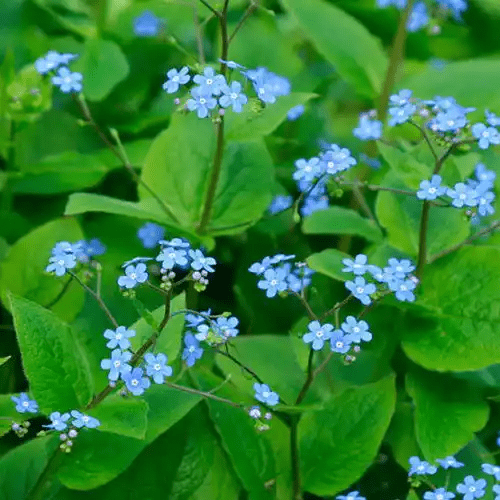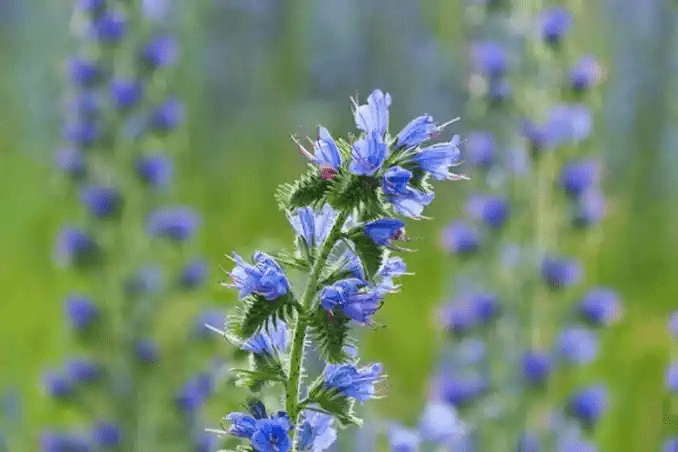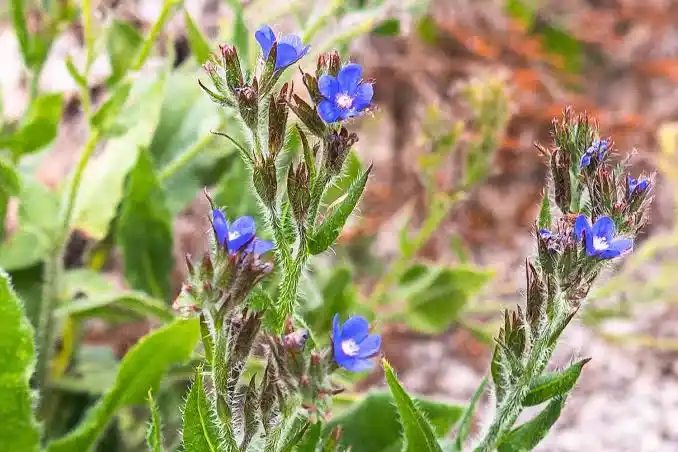Bugloss, a botanical marvel that graces the natural landscapes with its vibrant hues and distinctive features, is a flowering plant that belongs to the Boraginaceae family.
This genus encompasses several species, each contributing to the diverse tapestry of flora around the world. With its rich historical significance and unique characteristics, Bugloss captivates the attention of botanists, horticulturists, and nature enthusiasts alike.
One of the defining features of Bugloss is its strikingly brilliant flowers, which form in dense clusters and boast an array of colors, including vivid blues, pinks, and purples.
These blossoms, shaped like funnel bells, create a visually stunning spectacle that adds a touch of elegance to meadows, gardens, and woodland edges where Bugloss thrives.
The plant’s ability to adapt to various environments and soil types enhances its appeal, making it a versatile and resilient addition to diverse ecosystems.
The leaves of Bugloss are lance-shaped and covered in fine, bristly hairs, providing the plant with a distinctive texture. This characteristic not only contributes to the overall aesthetic appeal but also serves a functional purpose, acting as a deterrent to herbivores.
The plant’s rugged exterior is a testament to its adaptability and survival strategies in the face of environmental challenges.
Bugloss is not only renowned for its visual allure but also for its historical significance. In medieval times, this plant was believed to possess healing properties, and its roots were often used in traditional medicine.
The infusion of Bugloss was thought to alleviate respiratory ailments and promote overall well-being. While modern science has brought a more nuanced understanding of medicinal plants, Bugloss’s historical importance remains an integral part of its story.
Beyond its historical uses, Bugloss also plays a crucial role in supporting local ecosystems. Its nectar-rich flowers attract a variety of pollinators, including bees and butterflies, making it an essential component of the ecological web.
The plant’s contribution to biodiversity underscores its ecological value, emphasizing the interconnectedness of all living organisms within a given habitat.
Cultivating Bugloss in gardens has become a popular choice among horticulturists seeking to enhance the beauty of their landscapes. The plant’s adaptability, coupled with its low maintenance requirements, makes it an attractive option for both novice and seasoned gardeners.
Whether as a border plant or a focal point in a wildflower garden, Bugloss’s presence adds a touch of natural charm and diversity to any outdoor space.
Bugloss stands as a testament to the beauty and resilience of nature. Its vibrant flowers, unique foliage, and historical significance make it a captivating subject of study and admiration. From its medieval medicinal uses to its role in contemporary gardens, Bugloss continues to enchant and contribute to the rich tapestry of botanical wonders that grace our planet.
The Botanical Description of Bugloss
1. Growth Form: Bugloss, scientifically known as Anchusa, encompasses herbaceous perennials or biennials, varying in height and structure.
2. Leaves and Foliage: Lance-shaped leaves covered in bristly hairs, offering a rough texture; colors may include green, silver, or grayish tones.
3. Inflorescence: Bugloss produces distinct inflorescences with tightly packed clusters of tubular flowers, attracting pollinators like bees and butterflies.
4. Floral Characteristics: Tubular flowers with five petals, often brightly colored in shades of blue, purple, pink, or white; may have contrasting centers.
5. Stem Structure: Sturdy and upright stems, supporting clustered flowers; plant form varies, from bushy to upright and spire-like.
6. Root System: Taproot system providing stability and resilience, anchoring the plant securely in the soil.
7. Reproductive Strategy: Both sexual (seed production) and asexual (vegetative propagation) reproduction for genetic continuity.
8. Adaptations to Climate: Resilient to various climates, showcasing adaptability to temperate and Mediterranean conditions.
9. Seasonal Characteristics: Seasonal flowering with vibrant blooms during specific times, reflecting adaptation to seasonal changes.
10. Ecological Interactions: Supports pollinator populations, contributing to biodiversity and ecosystem health.
The Geographic Distribution of Bugloss
1. Native Regions: Bugloss is native to Europe, Asia, and Africa, adapting to meadows, grasslands, rocky slopes, and coastal areas.
2. European Presence: Common in the United Kingdom, France, Spain, and Italy, showcasing adaptability to diverse European climates.
3. Mediterranean Environments: Thrives in Mediterranean climates, with hot, dry summers and mild, wet winters.
4. Asian Habitats: Found in the Middle East to Central Asia, adapting to arid and semi-arid regions.
5. African Distribution: Present in northern regions to sub-Saharan areas, contributing to African floral diversity.
6. Naturalized Areas: Some Bugloss species naturalized in new territories, facilitated by human activities like trade and cultivation.
7. Coastal Habitats: Thrives in coastal regions with tolerance to salt spray and sandy soils.
8. Altitudinal Range: Adaptable to different altitudinal ranges, from lower elevations to mountainous areas.
The Chemical Composition of Bugloss
1. Alkaloids: Bugloss contains alkaloids, organic compounds with diverse physiological effects for plant defense.
2. Pyrrolizidine Alkaloids: Some Bugloss species contain pyrrolizidine alkaloids, raising concerns for potential toxicity.
3. Essential Oils: Bugloss produces essential oils with fragrance and potential applications in aromatherapy and traditional medicine.
4. Tannins: Presence of tannins contributes to astringency and potential antioxidant properties.
5. Flavonoids: Bugloss contains flavonoids with antioxidant and anti-inflammatory properties.
6. Fatty Acids: Seeds are a source of essential fatty acids, including omega-3 and omega-6.
7. Phenolic Compounds: Various phenolic compounds contribute to Bugloss’s antioxidant capacity.
8. Beta-Sitosterol: Bugloss contains beta-sitosterol, studied for potential cholesterol-lowering effects.
9. Trace Elements: Accumulates trace elements like calcium, potassium, and magnesium from the soil.
10. Anthocyanins: Some Bugloss species exhibit vibrant flower colors due to anthocyanins, offering visual appeal and potential antioxidant properties.
Read Also: 17 Medicinal Health Benefits Of Guggul (Commiphora wightii)
The Medicinal Health Benefits Of Bugloss

1. Anti-Inflammatory Properties: Bugloss, known for its anti-inflammatory effects, may aid in reducing inflammation in various body parts, providing relief for inflammatory conditions.
2. Respiratory Health Support: Bugloss has traditional uses in supporting respiratory health, potentially alleviating respiratory issues and contributing to overall lung function.
3. Skin Conditions Treatment: Bugloss is utilized to treat various skin ailments, and its properties may contribute to soothing the skin and promoting overall skin health.
4. Antioxidant Action: Rich in antioxidants, Bugloss plays a crucial role in neutralizing free radicals in the body, contributing to overall health and well-being.
5. Gastrointestinal Aid: Bugloss supports gastrointestinal health, with properties that may soothe the digestive system, alleviate discomfort, and promote a healthy gut.
6. Cardiovascular Support: Some studies suggest that Bugloss may offer cardiovascular benefits by supporting factors such as blood circulation and cholesterol levels.
7. Immune System Enhancement: Bugloss is believed to have immunomodulatory effects, enhancing the activity of the immune system and fortifying the body’s defense mechanisms.
8. Stress and Anxiety Reduction: Traditionally used to alleviate stress and anxiety, Bugloss’s calming properties may contribute to relaxation and a sense of well-being.
9. Diuretic Effects: Bugloss is known for its diuretic effects, aiding in promoting healthy kidney function and reducing water retention in the body.
10. Wound Healing Acceleration: Bugloss’s potential wound-healing acceleration is due to its antimicrobial effects, contributing to preventing infections in wounds.
11. Anti-Rheumatic Benefits: Bugloss has been traditionally used for its anti-rheumatic properties, offering potential relief from rheumatism and supporting joint health.
12. Anti-Anxiety Effects: Bugloss may have anti-anxiety effects, providing a natural remedy for individuals dealing with stress and anxiety-related issues.
13. Menstrual Symptom Relief: Traditional uses of Bugloss involve relieving symptoms associated with menstruation, such as cramps and discomfort.
14. Antiviral Properties: Research suggests that Bugloss may possess antiviral properties, potentially assisting in the management of viral infections.
15. Liver Health Support: Bugloss has been linked to liver health support, with properties that may contribute to the detoxification and well-being of the liver.
The Methods of Usage to Achieve the Provided Health Benefits Of Bugloss (Common Name)
1. Infusions and Teas: Prepare infusions or teas using Bugloss leaves or flowers to extract beneficial compounds for respiratory health, stress reduction, and antioxidant benefits.
2. Topical Applications: Incorporate Bugloss into creams or ointments for topical applications, effectively addressing skin conditions and promoting overall skin health.
3. Tinctures: Consume alcohol-based Bugloss extracts in small amounts as tinctures to enjoy concentrated medicinal properties.
4. Culinary Uses: Add Bugloss to salads, soups, or stews for its potential gastrointestinal and anti-inflammatory benefits, incorporating it into daily meals.
5. Capsule Supplements: Access Bugloss in capsule form as a dietary supplement for a convenient and controlled dosage of concentrated benefits.
6. Poultices: Apply Bugloss poultices directly to wounds or inflamed areas for localized relief, utilizing its potential wound-healing and anti-inflammatory properties.
7. Aromatherapy: Use Bugloss essential oil in aromatherapy for inhalation, contributing to stress reduction and relaxation.
8. Infused Oils: Create infused oils with Bugloss for topical application, suitable for massage or as a base for skincare products.
9. Herbal Baths: Add Bugloss to herbal baths for overall relaxation and skin health, allowing therapeutic properties to be absorbed through the skin.
10. Compresses: Make Bugloss compresses by soaking a cloth in a Bugloss infusion or decoction, applying them to specific areas for targeted relief, such as joint pain or skin conditions.
The Side Effects Of Using Bugloss Medicinal Plant
1. Skin Sensitivity: Topical application of Bugloss may lead to skin sensitivity or irritation in some individuals; perform a patch test before extensive use.
2. Allergic Reactions: Exercise caution if allergic to plants in the Boraginaceae family, to which Bugloss belongs, to avoid potential allergic reactions.
3. Gastrointestinal Discomfort: Excessive consumption of Bugloss may lead to gastrointestinal discomfort such as nausea or indigestion.
4. Photosensitivity: Some individuals may experience photosensitivity after topical application, making them more prone to sunburn.
5. Pregnancy and Breastfeeding: Consult healthcare professionals before using Bugloss during pregnancy or breastfeeding, as its safety during these periods is not well-established.
6. Medication Interactions: Bugloss may interact with certain medications, particularly those affecting the liver or with diuretic effects; consult with a healthcare provider.
7. Pyrrolizidine Alkaloids: Some Bugloss species may contain pyrrolizidine alkaloids, which can be toxic to the liver in high doses; ensure the Bugloss species used is low in pyrrolizidine alkaloids.
8. Blood Pressure Effects: Bugloss may have hypotensive effects; individuals with low blood pressure should use it cautiously, with regular blood pressure monitoring.
9. Hormonal Effects: Consult healthcare professionals before using Bugloss if dealing with hormone-sensitive conditions due to potential hormonal effects.
10. Not Universally Suitable: Bugloss may not be suitable for everyone; individuals with specific health conditions should seek professional advice before use.
11. Photosensitivity Concerns: Topical applications may increase sensitivity to sunlight; take precautions to avoid excessive sun exposure.
12. Interaction with Sedatives: Bugloss may have mild sedative effects; caution is advised when using it in combination with sedative medications.
13. Potential Allergens: Individuals with known allergies to similar plants should be cautious, as Bugloss may share allergenic components.
14. Liver Health Considerations: Due to the presence of pyrrolizidine alkaloids, individuals with liver conditions should exercise caution and seek professional guidance.
15. Monitoring for Adverse Reactions: Users of Bugloss should monitor for any adverse reactions and discontinue use if unexpected symptoms arise; professional advice is crucial for those with pre-existing health conditions.
Read Also: 18 Medicinal Health Benefits Of Guar Gum (Cyamopsis tetragonoloba)
The Scientific Research and Studies of Bugloss

1. Anti-Inflammatory Properties: Numerous scientific studies have explored Bugloss’s anti-inflammatory properties, examining its potential to reduce inflammatory markers and contribute to conditions such as arthritis.
2. Antioxidant Capacity: Scientific research has delved into Bugloss’s antioxidant capacity, identifying specific compounds responsible for scavenging free radicals and mitigating oxidative stress.
3. Respiratory Health Impact: Studies have investigated Bugloss’s impact on respiratory health, exploring its potential in managing respiratory conditions and promoting lung function.
4. Dermatological Applications: Scientific studies have scrutinized Bugloss’s dermatological applications, shedding light on its efficacy in treating skin conditions and promoting overall skin health.
5. Immunomodulatory Effects: Research suggests that Bugloss exhibits immunomodulatory effects, influencing the immune system’s activity to enhance defenses against infections and illnesses.
6. Cardiovascular Benefits: Scientific inquiries have focused on Bugloss’s cardiovascular benefits, examining its role in supporting heart health, improving circulation, and regulating cholesterol levels.
7. Anxiolytic and Stress-Relieving Properties: Studies have explored Bugloss’s anxiolytic properties, providing scientific insights into its potential to alleviate stress and anxiety-related symptoms.
8. Gastrointestinal Health: Research has investigated Bugloss’s effects on gastrointestinal health, examining its potential to soothe the digestive system, alleviate discomfort, and support a healthy gut.
9. Antimicrobial Activity: Scientific studies have delved into Bugloss’s antimicrobial activity, assessing its effectiveness against various pathogens and its potential role in preventing infections.
10. Wound Healing Properties: Studies have explored Bugloss’s wound healing properties, investigating its ability to accelerate the healing process and prevent infections in wounds.
11. Anti-Rheumatic Effects: Scientific research has examined Bugloss’s anti-rheumatic effects, providing insights into its potential to alleviate symptoms associated with rheumatism and joint conditions.
12. Hepatoprotective Potential: Studies have investigated Bugloss’s hepatoprotective potential, exploring its ability to support liver health and protect against liver-related issues.
The Safety Precautions and Recommendations In Using Bugloss Medicinal Plant
1. Allergic Reactions: Individuals should be aware of potential allergic reactions to Bugloss. Conduct a patch test before extensive use, especially if allergic to plants in the Boraginaceae family.
2. Dosage Moderation: Exercise caution regarding dosage. Consuming excessive amounts of Bugloss, especially in concentrated forms, may lead to adverse effects, including gastrointestinal discomfort.
3. Photosensitivity Awareness: Bugloss may increase sensitivity to sunlight. Users, especially those applying Bugloss topically, should take precautions to avoid excessive sun exposure.
4. Pregnancy and Breastfeeding: Pregnant and breastfeeding individuals should consult healthcare professionals before using Bugloss, as its safety during these periods is not well-established.
5. Medication Interactions: Bugloss may interact with certain medications, particularly those affecting the liver or with diuretic effects. Consultation with a healthcare provider is advised for individuals on medications.
6. Pyrrolizidine Alkaloids Check: Some Bugloss species may contain pyrrolizidine alkaloids, which can be toxic to the liver. Ensure the Bugloss species used is low in pyrrolizidine alkaloids.
7. Blood Pressure Effects: Bugloss may have hypotensive effects. Individuals with low blood pressure should use it cautiously, with regular blood pressure monitoring.
8. Hormonal Effects Consideration: Due to potential hormonal effects, individuals with hormone-sensitive conditions should consult healthcare professionals before using Bugloss.
9. Liver Health Monitoring: Individuals with liver conditions should exercise caution when using Bugloss and seek professional guidance due to potential hepatotoxicity concerns.
10. Not Universal Suitability: Bugloss may not be suitable for everyone. Individuals with specific health conditions should seek professional advice before use.
11. Adverse Reactions Monitoring: Users should monitor for any adverse reactions and discontinue use if unexpected symptoms arise. Professional advice is crucial for those with pre-existing health conditions.
12. Sunscreen Application: Users applying Bugloss topically should consider using sunscreen to protect against potential photosensitivity and sunburn.
FAQs About Bugloss Medicinal Plant
1. Is Bugloss Safe for Daily Consumption?
Yes, Bugloss is generally safe for daily consumption when used in moderate amounts. However, individuals with specific health conditions or allergies should consult healthcare professionals.
2. Can Bugloss be Applied Topically for Skin Conditions?
Yes, Bugloss can be applied topically for various skin conditions. Create infused oils or creams for skin application, but conduct a patch test to check for sensitivities.
3. Does Bugloss Interact with Common Medications?
Bugloss may interact with medications affecting the liver or with diuretic effects. It’s advisable to consult with a healthcare provider if taking such medications.
4. Are There Different Varieties of Bugloss with Varying Properties?
Yes, there are different species of Bugloss, and their properties can vary. Ensure the specific species used aligns with intended medicinal purposes.
5. Can Pregnant Women Use Bugloss?
Pregnant women should consult healthcare professionals before using Bugloss, as its safety during pregnancy is not well-established.
6. How Long Does it Take to See Results from Bugloss Usage?
The time to see results from Bugloss usage varies depending on the health concern. Some individuals may experience benefits relatively quickly, while others may take longer.
7. Can Bugloss Be Used Alongside Other Herbal Supplements?
Bugloss can be used alongside other herbal supplements, but it’s essential to be aware of potential interactions. Consultation with a healthcare professional is recommended.
8. What Precautions Should Individuals with Liver Conditions Take When Using Bugloss?
Individuals with liver conditions should exercise caution when using Bugloss due to potential hepatotoxicity concerns. Professional guidance is advisable.
9. Are There Any Age Restrictions for Bugloss Usage?
Bugloss is generally suitable for adults. However, usage for children and the elderly should be done under the guidance of healthcare professionals.
10. Can Bugloss Replace Prescription Medications?
Bugloss should not be considered a replacement for prescription medications without consultation with healthcare professionals. It can be used as a complementary approach.
Read Also: What You Should Know About Spider Monkey

